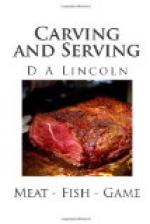It is comparatively a slight matter to carve a solid mass of lean meat. It is the bones, tough gristle, and tendons, that interfere with the easy progress of the knife. To expect any one to carve well without any conception of the internal structure of what may be placed before him is as absurd as to expect one to amputate a limb successfully who has no knowledge of human anatomy.
Some notion of the relative position of bones, joints, fat, tough and tender muscles, is the first requisite to good carving. All agree that skill in carving may be acquired by practice; and so it may. Any one can divide a joint if he cut and hack at it long enough, and so learn after a time just where to make the right cut. But a more satisfactory way is to make a careful study before the material is cooked, and thus learn the exact position of every joint, bone, and muscle. Become familiar with a shoulder or a leg of mutton; locate the joints by moving the bones in the joints, or by cutting it into sections, some time when it is to be used for a stew. Or remove the bone in the leg by scraping the meat away at either end. Learn to distinguish the different cuts of meat. The best way to learn about carving poultry and game is to cut them up for a stew or fricassee, provided care be taken not to chop them, but to disjoint them skilfully.
Then, when you attempt to carve, do the best you can every time. Never allow yourself to be careless about it, even should the only spectators be your wife and children. But do not make your first effort in the art at a company dinner. Every lady should learn the art. There is no reason why she may not excel in it, as she has every opportunity to study the joint or fowl before cooking. Strength is not required, so much as neatness and care. A firm, steady hand, a cool, collected manner, and confidence in one’s ability will help greatly. Children also should be taught this accomplishment, and should be taught it as soon as they can handle a knife safely. If parents would allow the children to share their duties at the daily family table, and occasionally when company is present, a graceful manner would soon be acquired. When called upon to preside over their own homes there would less frequently be heard the apology, “Father always carved at home, and I have had no practice.” The only recollection that I now have of a dinner at a friend’s some years ago is the easy and skilful way a young son of my hostess presided at the head of the table, while the father occupied the place of guest at the mother’s right hand.
One must learn first of all to carve neatly, without scattering crumbs or splashing gravy over the cloth or platter; also to cut straight, uniform slices. This may seem an easy matter; but do we often see pressed beef, tongue, or even bread cut as it should be? Be careful to divide the material in such a manner that each person may be served equally well. Have you never received all flank, or a hard dry wing,




